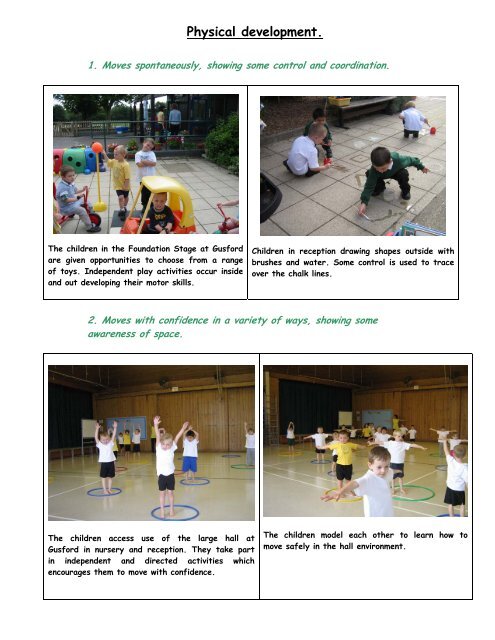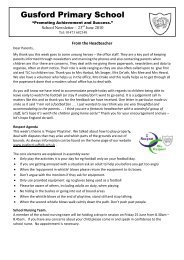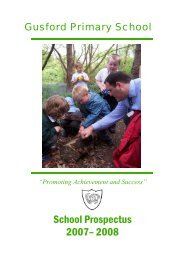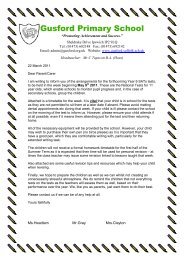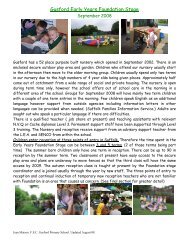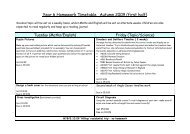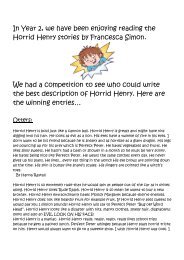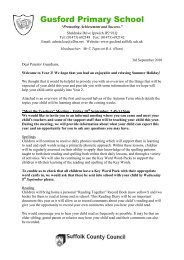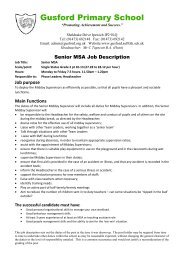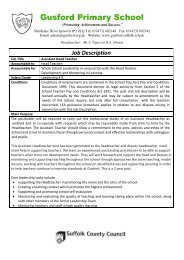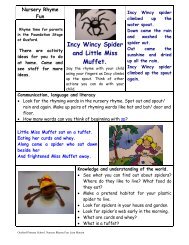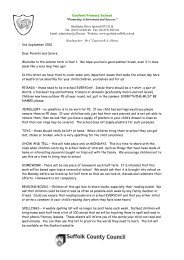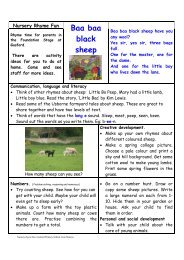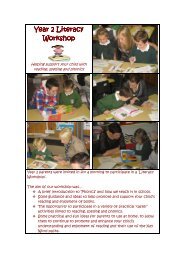Physical development. - Gusford Primary School
Physical development. - Gusford Primary School
Physical development. - Gusford Primary School
You also want an ePaper? Increase the reach of your titles
YUMPU automatically turns print PDFs into web optimized ePapers that Google loves.
<strong>Physical</strong> <strong>development</strong>.<br />
1. Moves spontaneously, showing some control and coordination.<br />
The children in the Foundation Stage at <strong>Gusford</strong><br />
are given opportunities to choose from a range<br />
of toys. Independent play activities occur inside<br />
and out developing their motor skills.<br />
Children in reception drawing shapes outside with<br />
brushes and water. Some control is used to trace<br />
over the chalk lines.<br />
2. Moves with confidence in a variety of ways, showing some<br />
awareness of space.<br />
The children access use of the large hall at<br />
<strong>Gusford</strong> in nursery and reception. They take part<br />
in independent and directed activities which<br />
encourages them to move with confidence.<br />
The children model each other to learn how to<br />
move safely in the hall environment.
3. Usually shows appropriate control in large and small- scale<br />
movements.<br />
Children in a role play situation in reception show<br />
control when wheeling a barrow over ‘the bridge in<br />
Percy the park Keeper’s’ wood.’<br />
Fine motor control was shown as these young<br />
children went fishing in the outside area.<br />
Taking turns pedalling round the play area at<br />
<strong>Gusford</strong>. Children use a range of wheeled bikes to<br />
develop gross motor skills.<br />
Children in Foundation cooperating with the<br />
parachute. They worked together control the<br />
movement of the parachute on the school field.
4. Moves with confidence, imagination and in safety. Travels around,<br />
under, over and through balancing and climbing equipment. Shows<br />
awareness of space, of self and others.<br />
The children in reception gain confidence to move safely over apparatus in<br />
the large hall. They learn to move in a variety of ways, balancing and<br />
climbing.<br />
The children learn to move over, under and through different apparatus in<br />
the hall at <strong>Gusford</strong>. They begin to learn to be aware of each other when<br />
moving round the room.
5. Demonstrates fine –motor control and coordination.<br />
Children in reception learn to use a variety of<br />
implements to develop and refine their fine motor<br />
skills. Cutting, drawing, threading, and tracing<br />
activities are offered to the children.<br />
The use of dry wipe pens and whiteboards give<br />
the children confidence to draw and write.<br />
Results can easily be wiped off and started<br />
again.<br />
5<br />
Pattern making using oil pastels help this child to<br />
develop fine motor control.<br />
Fine motor control is being developed here as<br />
peanuts are threaded onto string. These strings<br />
were later hung in the garden to feed our<br />
winter birds.
6. Use small and large equipment, showing a range of basic skills.<br />
Using large apparatus on a regular basis in the large hall helps develop young<br />
children’s gross motor skills. They learn to walk, balance, turn, crawl and jump<br />
on a range of equipment.<br />
Children select from a range of small apparatus in the outside area. Their<br />
balance and coordination is developed!
7. Handles tools, objects, construction and malleable materials safely<br />
and with basic control.<br />
The children in reception learn to use a variety<br />
of implements. These children learnt how to use<br />
brown tape to wrap around balloons in order to<br />
make mini beasts in summer.<br />
These children joined in with their parents at a<br />
‘Family Learning’ workshop. They used a range of<br />
materials and handled basic tools.<br />
Independent access to a range of materials and<br />
equipment. Children were able to choose<br />
implements and equipment to fix items together.
8. Recognises the importance of keeping healthy and those things which<br />
contribute to this. Recognises the changes that happens to her/his body<br />
when s/he is active.<br />
These children in reception prepared a ‘healthy<br />
meal’ for the whole class. They grew the<br />
tomatoes and lettuce in their garden at school.<br />
The class talked about what made a healthy<br />
balanced meal.<br />
The children went on a local walk with their<br />
parents. As they walked up the hill they realised<br />
that they were out of breath and that their heart<br />
was beating faster.<br />
Running round the playground on a windy day<br />
brought up the discussion in class afterwards<br />
about why the children were panting.<br />
Sharing a healthy meal at school with friends.
9. Repeats, links and adapts simple movements, sometimes<br />
commenting on her/his work. Demonstrates coordination and<br />
control in large and small movements, and in using a range of tools<br />
and equipment.<br />
The children tried to ‘catch’ the wind on a very<br />
windy day. They ran about the playground<br />
swirling and twirling with the leaves.<br />
Children in reception taking turns pulling the<br />
wooden cart around the play area. Careful control<br />
was needed for the sharp turns!<br />
Taking part in active singing in the swimming<br />
pool. Coordination was needed to sing and dance<br />
the ‘Hokey Cokey.’<br />
Dancing together as the children moved round the<br />
playground singing pirate songs.


